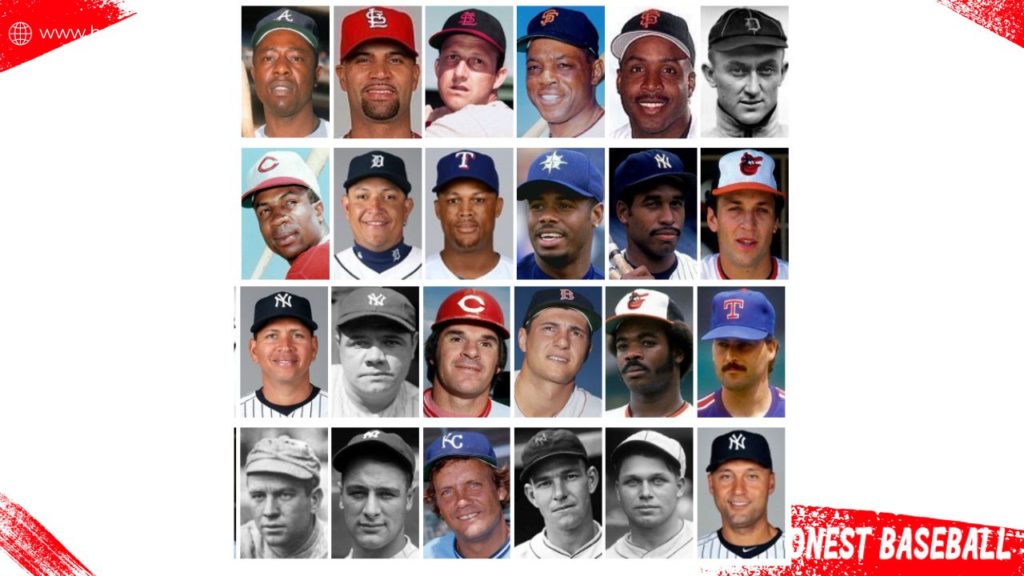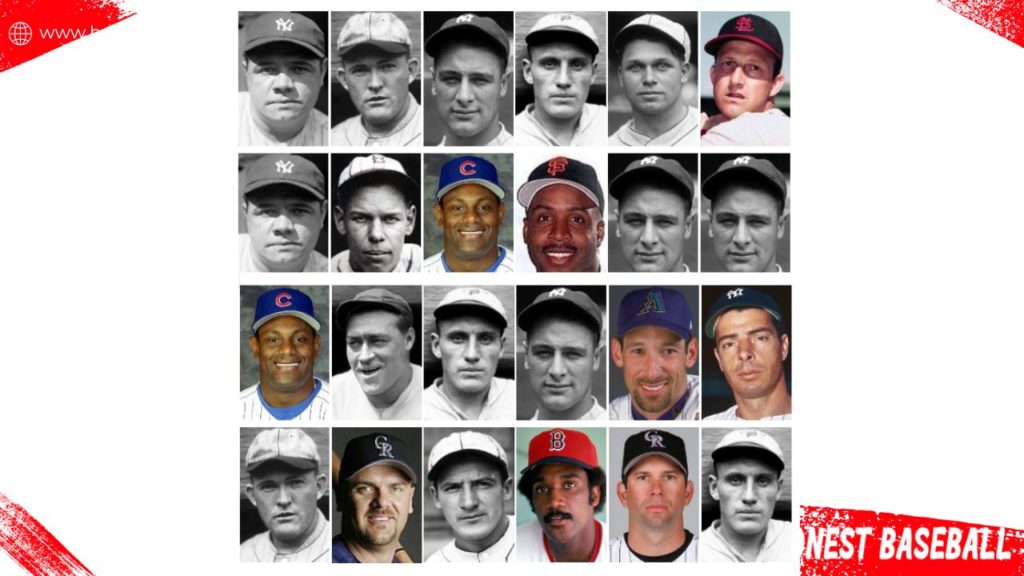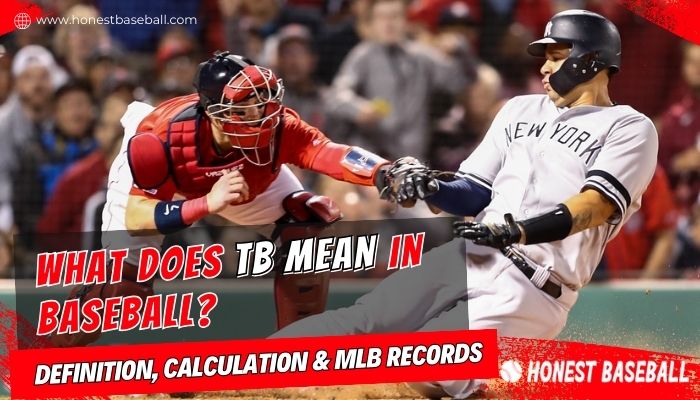Many early-stage players and fans don’t understand the garden of baseball terminology used in the records and scorebooks. One such term is TB. So, you’re not the first guy to ask me this question: what does TB mean in baseball? Well, let’s cut to the chase and find out!
In baseball statistics, “TB” is an abbreviation that stands for Total Bases. Understanding the meaning of TB is essential for analyzing a player’s hitting performance. It provides valuable insights into a player’s offensive contributions throughout a season.
Total Bases take into account all the bases a player reaches through hits – singles, doubles, triples, and home runs. By calculating the total number of bases accumulated by a player, we can gauge their overall effectiveness at getting on base and advancing around it.
In this article, I’m talking about the TB definition, its impacts on players’ evaluation, career leaders, and the highest scorer in a single season. Let’s head into the discussion.
Definition of Total Bases (TB) in Baseball
Total bases (TB) is a baseball statistic that credits a batter for the number of bases reached from a hit. It combines singles, doubles, triples, and home runs into a single metric to evaluate a batter’s production. The formula for calculating total bases is:
- Single = 1 base
- Double = 2 bases
- Triple = 3 bases
- Home run = 4 bases
For example, if a batter hits 2 singles, 1 double, and 1 home run in a match, the total bases or TB for that team will be:
- 2 singles x 1 base = 2 bases
- 1 double x 2 bases = 2 bases
- 1 home run x 4 bases = 4 bases
So their total bases = 2 + 2 + 4 = 8
The total bases figure summarizes a batter’s power and help on offense. Players with more total base generally have more extra-base knocks and bring in more runs. Comparing total bases over a season or career allows comparing players in terms of their offensive production.
Impact of Total Bases on Player Evaluations and Accolades
Total Bases (TB) are a crucial metric. It provides an objective measure that goes beyond just looking at the batting average, allowing us to evaluate power and extra-base hit production. Let’s dive into why Total Bases matter in baseball.

Total Base Calculations Help in Evaluating Offensive Performances
Hitting is about more than just batting average. Total bases help reveal a player’s full offensive ability. We gain insight into consistency, power, and run production by tracking total bases over time.
It helps determine how well they are advancing base runners and contributing to their team’s success. The higher the total bases, the more impactful the hitter is considered to be.
Total Base Allows Comparing Hitters’ Performance
With this statistic, you can understand and make comparisons between different hitters. It becomes easy to identify who is generating more offense by accumulating extra-base hits like doubles, triples, and home runs.
For instance, if Player A has 20 singles and 5 home runs, they would accumulate 40 total bases. In comparison, if Player B has 10 singles and 10 doubles, they would also accumulate 40 total bases. However, Player A’s extra-base hits, in this case, demonstrate greater power potential.
Of course, walks, stolen bases, context, and many other factors matter too. But a high total base count indicates a dangerous hitter adept at advancing runners and sparking rallies.
For coaches and scouts, it’s an essential metric that captures offensive impact beyond just batting average.
Total Base Counts for Overtime Batters’ Performance
By tracking Total Bases over multiple games or an entire season, you can get valuable information about a player’s consistency and overall offensive output.
Therefore, you’ll see when a batter consistently accumulates high total bases throughout the season, and he’s considered to have the ability to consistently generate offense for his team.
MLB Highest Career Total Base Records

Hank Aaron, nicknamed “Hammerin’ Hank,” is still the All-Time leader for total bases in the history of MLB. Let’s check out other famous baseball players who’ve marked their footsteps in the record.
Source – List of Major League Baseball career total bases leaders (Wikipedia)
| Rank | Player (years) | Total Bases | PA | Bats |
| 1. | Henry Aaron (23) | 6856 | 13941 | R |
| 2. | Albert Pujols (22) | 6211 | 13041 | R |
| 3. | Stan Musial (22) | 6134 | 12721 | L |
| 4. | Willie Mays (23) | 6080 | 12545 | R |
| 5. | Barry Bonds (22) | 5976 | 12606 | L |
| 6. | Ty Cobb (24) | 5854 | 13103 | L |
| 7. | Alex Rodriguez (22) | 5813 | 12207 | R |
| 8. | Babe Ruth (22) | 5793 | 10627 | L |
| 9. | Pete Rose (24) | 5752 | 15890 | B |
| 10. | Carl Yastrzemski (23) | 5539 | 13992 | L |
| 11. | Eddie Murray (21) | 5397 | 12817 | B |
| 12. | Rafael Palmeiro (20) | 5388 | 12046 | L |
| 13. | Frank Robinson (21) | 5373 | 11744 | R |
| 14. | Miguel Cabrera (21) | 5356 | 11778 | R |
| 15. | Adrián Beltré (21) | 5309 | 12130 | R |
| 16. | Ken Griffey Jr. (22) | 5271 | 11304 | L |
| 17. | Dave Winfield (22) | 5221 | 12358 | R |
| 18. | Cal Ripken Jr. (21) | 5168 | 12883 | R |
| 19. | Tris Speaker (22) | 5101 | 12020 | L |
| 20. | Lou Gehrig (17) | 5060 | 9665 | L |
| 21. | George Brett (21) | 5044 | 11625 | L |
| 22. | Mel Ott (22) | 5041 | 11347 | L |
| 23. | Jimmie Foxx (20) | 4956 | 9677 | R |
| 24. | Derek Jeter (20) | 4921 | 12602 | R |
| 25. | Ted Williams (19) | 4884 | 9792 | L |
| 26. | Honus Wagner (21) | 4870 | 11766 | R |
| 27. | Paul Molitor (21) | 4854 | 12167 | R |
| 28. | Al Kaline (22) | 4852 | 11597 | R |
| 29. | Reggie Jackson (21) | 4834 | 11418 | L |
| 30. | Manny Ramirez (19) | 4826 | 9774 | R |
MLB Highest Total Base Records in a Single Season

This is the list of highest total base records in a single season in the history of baseball.
Source – Single-Season Leaders & Records for Total Bases (Baseball Reference)
| Rank | Player (age) | Total Bases | Year | PA | Bats |
| 1. | Babe Ruth (26) | 457 | 1921 | 693 | L |
| 2. | Rogers Hornsby (26) | 450 | 1922 | 704 | R |
| 3. | Lou Gehrig (24) | 447 | 1927 | 717 | L |
| 4. | Chuck Klein (25) | 445 | 1930 | 722 | L |
| 5. | Jimmie Foxx (24) | 438 | 1932 | 702 | R |
| 6. | Stan Musial (27) | 429 | 1948 | 698 | L |
| 7. | Sammy Sosa (32) | 425 | 2001 | 711 | R |
| 8. | Hack Wilson (30) | 423 | 1930 | 709 | R |
| 9. | Chuck Klein (27) | 420 | 1932 | 711 | L |
| 10. | Lou Gehrig (27) | 419 | 1930 | 703 | L |
| 11. | Luis Gonzalez (33) | 419 | 2001 | 728 | L |
| 12. | Joe DiMaggio (22) | 418 | 1937 | 692 | R |
| 13. | Babe Ruth (32) | 417 | 1927 | 691 | L |
| 14. | Babe Herman (27) | 416 | 1930 | 699 | L |
| 15. | Sammy Sosa (29) | 416 | 1998 | 722 | R |
| 16. | Barry Bonds (36) | 411 | 2001 | 664 | L |
| 17. | Lou Gehrig (28) | 410 | 1931 | 738 | L |
| 18. | Lou Gehrig (31) | 409 | 1934 | 690 | L |
| 19. | Rogers Hornsby (33) | 409 | 1929 | 712 | R |
| 20. | Larry Walker (30) | 409 | 1997 | 664 | L |
| 21. | Joe Medwick (25) | 406 | 1937 | 677 | R |
| 22. | Jim Rice (25) | 406 | 1978 | 746 | R |
| 23. | Todd Helton (26) | 405 | 2000 | 697 | L |
| 24. | Chuck Klein (24) | 405 | 1929 | 679 | L |
| 25. | Hal Trosky (23) | 405 | 1936 | 671 | L |
| 26. | Jimmie Foxx (25) | 403 | 1933 | 670 | R |
| 27. | Lou Gehrig (33) | 403 | 1936 | 719 | L |
| 28. | Todd Helton (27) | 402 | 2001 | 697 | L |
| 29. | Henry Aaron (25) | 400 | 1959 | 693 | R |
| 30. | Albert Belle (31) | 399 | 1998 | 706 | R |
Other Key Baseball Statistics Related to Total Bases
Now, let’s talk about some other important statistics and numbers in baseball that are related to total bases, including the slugging percentage, isolated power, and on-base plus slugging.
Slugging Percentage (SLG)
A player’s slugging percentage is calculated by dividing total bases by at-bats, quantifying his extra-base power. The higher the slugging percentage, the greater a hitter’s ability to drive the ball for doubles, triples, and home runs. A low slugging percentage suggests reliance on singles and a lack of driving power.
Isolated Power (ISO)
Isolated power specifically measures raw power by subtracting the batting average from the slugging percentage. A high isolated power indicates tremendous extra-base hit potential and consistent hard contact.
Players with elite isolated power can frequently muscle balls over the fence. Those with lower isolated power produce fewer extra-base hits.
OPS (On-base Plus Slugging)
On-base plus slugging (OPS) combines on-base percentage with slugging percentage to assess overall offensive impact. It encapsulates a batter’s dual abilities to reach base while also hitting for power. Players who excel in both areas produce a high OPS. The top hitters post OPS marks well above .900 by excelling in all facets.
“These advanced stats help unveil a player’s complete offensive profile beyond just hits and batting average. Scouts use them to identify undervalued talents – players with subtle strengths hidden beneath the surface. While mere mathematical formulas, they unlock next-level evaluation when used properly.”
Frequently Asked Questions (FAQs)
Does a Walk Count as a TB in Baseball?
No, a walk (also known as a base on balls or BB) doesn’t count as a Total Base (TB) in baseball, and nor does it contribute to a player’s Total Bases. Total bases specifically mean the number of bases gained by a batter through his hits. So, only hits where the batter makes contact with the ball and advances a base count as a part of his total base statistic.
What Does BB Mean in Baseball?
The abbreviation “BB” in the sport of baseball signifies an occurrence in which the pitcher throws four pitches outside the strike zone, which the hitter does not attempt to hit. The hitter is then permitted to advance to first base.
This event is also frequently called a “walk.” I’ve shared additional information about the meaning of BB in baseball in a separate article.
What Does 2B Mean in Baseball?
In baseball, “2B” stands for “Second Base.” It refers to the defensive position on the field, and it’s also the name of one of the four bases on the baseball diamond. You can understand more about the 2B if you have an idea about the players’ positions on the baseball field.
Does a Run Count As a Total Base?
In official baseball scoring and stats, a run does not count as a base. The four bases are first, second, third, and home plate. When a runner crosses home plate, it counts as a run scored but not as a base reached. Runs are the scoring unit in baseball.
However, colloquially people sometimes refer to a run as a “base” in casual conversation as a shorthand way of conveying that a run was scored.
For example, someone might say “he hit a double and then scored on a single, so he got three bases”. Technically the runner touched first, second, and home plate, scoring 1 run. Only hits (singles, doubles, triples, home runs) count as total bases for a batter. Runs are tracked separately as a form of scoring.
What Counts As a Base in Baseball?
A base counts as each of the four corners that make up the diamond-shaped infield in the baseball field. There are a total of 4 bases in baseball:
- First Base: The first base (1B) is the initial point that a batter tries to advance or touch after hitting the ball in fair territory. It’s also the base that a baserunner needs to reach safely to be considered “on base.”
- Second Base: Second base or 2B is the next base after the first base that a runner needs to advance after successfully reaching first base.
- Third Base: After reaching second base, a runner aims to advance to third base (3B.)
- Home Plate: The home plate is the ultimate destination for a baserunner. When a runner successfully crosses home plate, they score a run for their team.
How Do Total Bases Differ from Runs Batted In (RBI)?
| Aspect | Total Bases (TB) | Runs Batted In (RBI) |
| Definition | Total number of bases gained through hits | Crediting a batter for making a play that results in a run being scored |
| Focus | The player’s ability to advance bases with hits | Player’s ability to drive in teammates already on base |
| Calculation | Assigns weighted values to hits: 1 base for single, 2 bases for double, 3 bases for triple, 4 bases for home run | Credits a batter when their plate appearance leads to a run |
| Dependency | Independent of whether other runners score | Depends on the performance of both the batter and runners on base |
| Individual Achievement | Measures the player’s offensive performance | Reflects a player’s contribution to team scoring |
| Example | A player hits a solo home run, accumulating 4 TB | A player hits a single with runners on base, earning RBIs for each runner who scores |
| Statistic for | Assessing a player’s ability to generate extra bases | Evaluating a player’s ability to drive in runs and contribute to team scoring |
Can Pitchers Also Accumulate Total Bases?
No, baseball pitchers don’t accumulate Total Bases (TB) in the same way that hitters do. Instead, pitchers are primarily evaluated based on their pitching performance, which includes factors like strikeouts, earned run average (ERA), wins, losses, and other pitching-related statistics.
Wrapping Up Everything About TB Mean in Baseball
That’s the wrap-up of what does TB mean in baseball. To summarize, TB is a valuable statistic for evaluating a baseball player’s offensive production. With this number, coaches and scouts or baseball fans gain meaningful insights about a hitter’s power, consistency, and ability to generate offense.
Star sluggers with lofty career totals like Hank Aaron and Albert Pujols demonstrate enduring extra-base power. Individual seasons marking new total base records, as authored by legends such as Babe Ruth and Lou Gehrig, reveal supreme plate proficiency.
Though only one piece of the puzzle, Total Bases supplies crucial context that basic stats miss. Slugging percentage, isolated power, on-base plus slugging, and more paint a comprehensive picture.
Check out more about batter’s scoring in baseball
How To Read A Baseball Scoreboard?
What Is A Perfect Game In Baseball?

Hello everyone. My name is Jason Butler, and I live in California, America. I was a professional AAA Minor League Baseball player. I lost my chance of playing MLB for injury issues, but I did not lose my love for baseball. I attended the coaching training program and am now working as a coach in a small school in San Diego.
I always love to share my experience and knowledge if that can help you. Play baseball, and stay fit.
